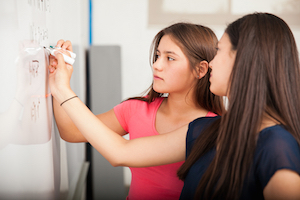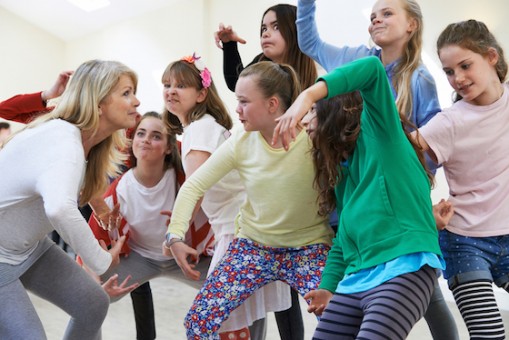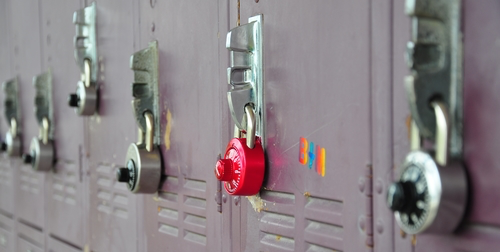How to Become a Tween-Centered Teacher
By Cheryl Mizerny
 Teaching middle school is unlike any other level of education. Early adolescents are not just large elementary school children, nor are they small adults. They are a unique animal with their own quirks and characteristics.
Teaching middle school is unlike any other level of education. Early adolescents are not just large elementary school children, nor are they small adults. They are a unique animal with their own quirks and characteristics.
Psychologists and some educators realized this back in the 60s and 70s and started the trend toward abolishing junior high school in favor of the middle school concept. In fact, the number of middle schools was 462 percent higher in 2000–01 than in 1970–71 (11,700 vs. 2,100). In 2015, middle schools outnumber junior highs in the U.S. almost five to one.
This trend is a no-brainer for those of us who are able to appreciate the distinct nature of young adolescents and what the job requires. Teaching middle school is a true Magical Mystery Tour (no offense to the Beatles).
 Rapid change, all over the place
Rapid change, all over the place
As new teachers (and those new to middle school) use their summers to plan for the coming school year, it’s important to keep in mind that early adolescents need classrooms tailored to their specific needs and aligned to their developmental stage if they’re going to be successful in school.
The challenge for middle school teachers is that the changes in their students occur rapidly and are widely varied. Dealing with these changes can feel overwhelming, but it can also be exciting. One key to help students achieve is to design your classroom and instruction with tweens in mind.
Designing a tween-centered learning environment helps assure that we have students who are actively engaged and invested, responsible for their own understanding of material, proficient in social interactions, and developing the strategies to become lifelong learners.
Meeting the many needs of tweens
Middle school is a time of tremendous growth and development – more so than any time since infancy. Students are struggling with the heightened expectations of adults, in addition to the confusing changes in their own bodies and emotions.

Let’s take a look at each of these areas through the tween lens. I am aware that a lot of what I’m about to share sounds like common sense and “just good teaching.” However, I am constantly surprised at how many middle school teachers focus on “preparing kids for high school” and “teaching them how to be adults” without taking into account that they are not developmentally ready for either of these experiences. These teachers treat them as tiny adults and are perplexed by how poorly their students perform. They fail to understand that kids cannot simply skip adolescence.
The Physical Tween
Teachers have all been through the puberty process and I don’t want to stir up any horrible memories, but I hope they keep in mind how truly out of control they felt most of this time. Tweens are acutely aware of their physical growth and changes, and how they respond to these changes can alter day by day and sometimes minute to minute. Teachers can help students deal with these changes by providing learning experiences that help students feel more comfortable in their own skin.
► Provide ample opportunities for students to move about the room freely, without having to ask permission (although you can discuss with them appropriate times to do so). Sometimes getting up to grab a tissue, sharpen a pencil, or throw something away can dissipate their excess energy.
► Allow them to go to the bathroom or get a drink more often than you may feel is necessary. As you well know, the point of these trips is not to use the restroom or hydrate. If their minds are distracted by some new sensation or a comment about their appearance by a peer, they are not going to be able to fully attend to instruction anyway, so let them go without too much of a fight.
► Incorporate emotionally safe ways for students to use their new bodies. For example, don’t single out one student to come to the front of room, but rather allow students to do so in groups or ask all students to stand up and perform a movement. Additionally, use physical body movements as part of learning a topic.
► Even though we tend to think of them as something primarily for younger children, incorporating brain breaks can be extremely useful in regaining tween attention.
► Over the course of a unit of study, students will learn and remember more if lessons include using all five senses. Music is especially motivating for young adolescents.
The Intellectual Tween
While scientists once thought of our brains as fully developed by this age, they now know this is not the case. Growth and changes abound and exciting things are happening. The best teachers take advantage of these developments.
► Students at this age are gaining perspective on their own thoughts and emotions as well as those of others. Use this as an opportunity to incorporate many opportunities for exploring topics from various perspectives, including topics that require empathy.

► One sensational, and often untapped, ability of tween brains is that they are becoming more flexible. They are able to manipulate information so as to understand metaphor, allegory, symbolism, and hypothetical situations. They also enjoy deductive reasoning tasks. I regularly incorporate all of these in my class and am pleasantly surprised with the depths of insight that result.
► Students at this age are curious and imaginative and enjoy tackling “big ideas.” Middle school is the perfect time to incorporate essential questions, real-world inquiry and problem solving tasks. It is a time ripe with divergent thinking and dissent. Encourage these creative tangents and provide the time, space, and materials for these explorations. Whenever possible, incorporate an authentic issue for them to grapple with. The results they achieve may surprise and even delight you (and them).
► While providing predictability and structure is crucial for this age range, novelty within these parameters is a huge stimulus. A wide variety of learning experiences and techniques enables students of all talents and backgrounds to shine. It also keeps them excited to come to your class every day.
► Aristotle said, “To find yourself, think for yourself.” At this age, tweens are becoming capable of understanding how their own brains work. This is the ideal time to introduce metacognitive strategies. Model your own thinking in front of them as you work through a problem, have them develop plans and monitor their own learning, show them how to visibly demonstrate their new knowledge, and help them deeply reflect on what they did well and what they can improve upon. Show them when to use the new strategies you’ve taught and what to do if they experience challenges. This is the key to students becoming proficient, lifelong learners.
The Social/Emotional Lens
Normally, I would separate these two categories, but they seem to be intertwined at the middle school level. Just as play is the primary job of early childhood, socialization is the duty of early adolescence. For these children, due to biological and environmental influences, emotional growth is heavily influenced by social experiences. The following ideas incorporate both facets of tween development because the curriculum needs to reflect sensitivity to both emotional and social issues.
► As tweens strive to develop their social identity, they often begin to express self-doubt and teachers will hear a lot of negative self-talk. For this reason, it is important for them to have a sense of self-efficacy, self-determination, and self-worth. It is crucial to help them understand how their actions can directly influence the results, how they are capable of being responsible for their own learning, and that they can experience success somehow. This is the ideal time to teach about a growth mindset and the benefits of failure as a learning tool.

► Early adolescents are now capable of appreciating multiple perspectives on an issue and to accept those of others. Curricular materials and experiences that allow students to express admiration, feel empathy, or explore morality are very interesting to students at this age because this kind of thinking is so new to them. I tap into their natural altruism whenever possible as well.
► At the time in their lives when group affiliation is paramount, individual differences can begin to feel most noticeable, divisive, and uncomfortable. It is very important to honor the diversity of your students and encourage them to explore, accept, and be proud of their own cultural identities. I am very careful to use multicultural materials in my classroom, as well as those that reflect the students’ own interests and talents.

► Finally, the concept of fairness is foremost in their minds. Try to administer any consequences (positive or negative) in a fair, consistent manner. Tweens can sniff out our favoritism from a mile away, whether it be real or perceived. It will pay off to be hyper-vigilant in ensuring that your students feel you have treated them well and fairly.
By exploiting the very things that make tweens who they are, you will allow your students to experience the magical journey that is middle school and will save yourself more than a few headaches along the way.
Cheryl Mizerny (@cherylteaches) is a veteran educator with 20+ years experience–most at the middle school level. She began her career in special education, became a teacher consultant and adjunct professor of Educational Psychology, and currently teaches 6th grade English in Bloomfield Hills, Michigan. Read more of her MiddleWeb articles here.
































